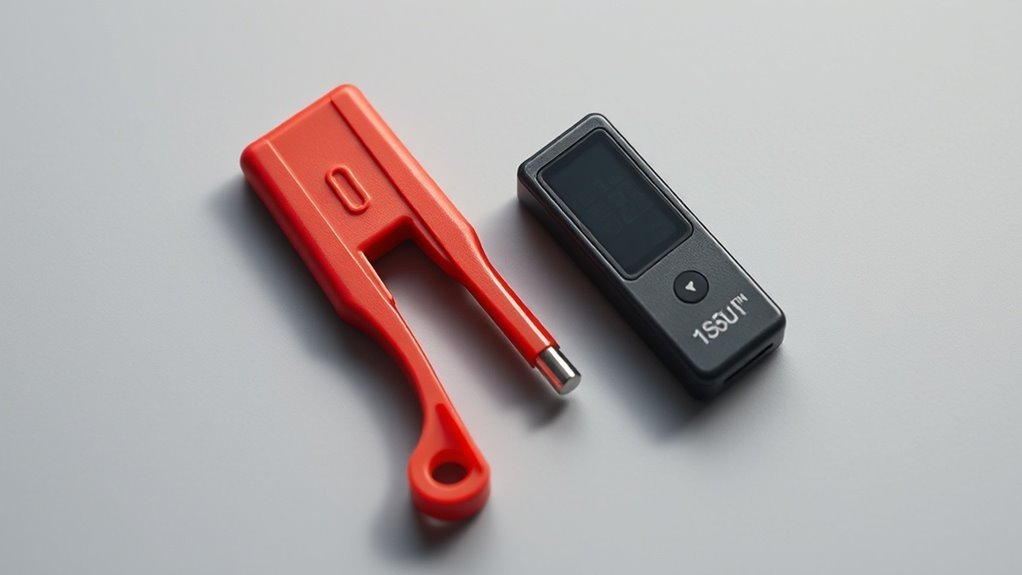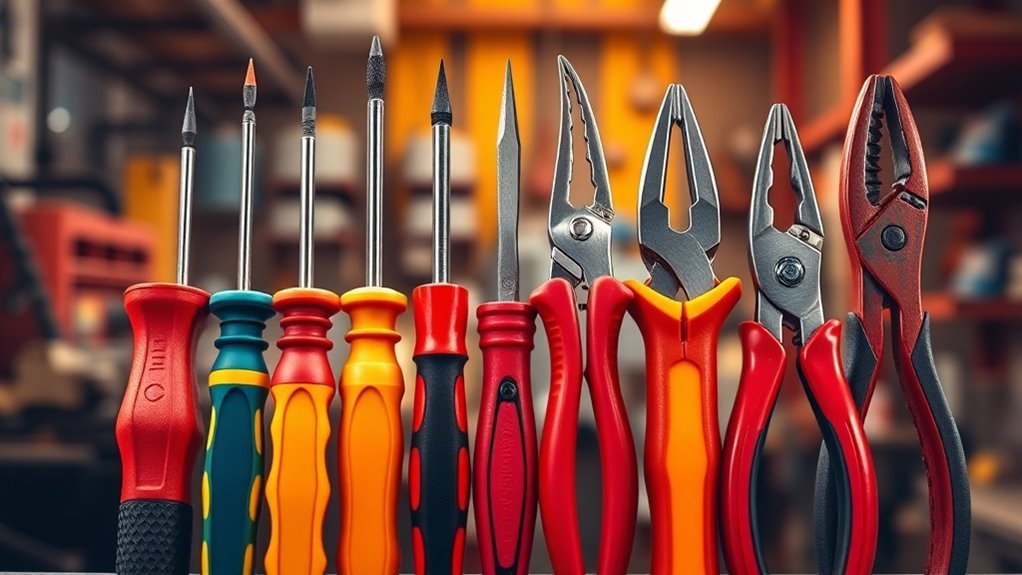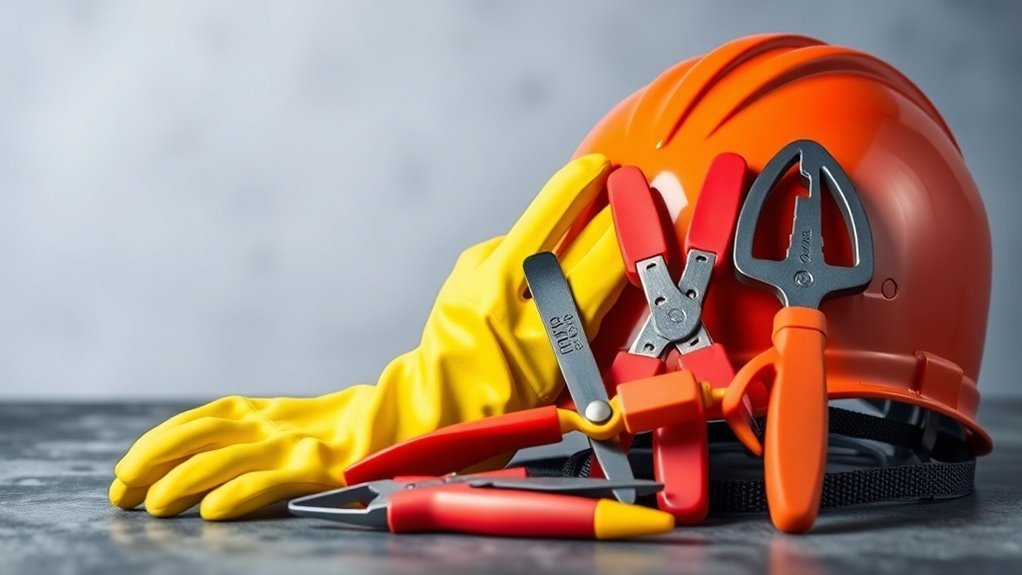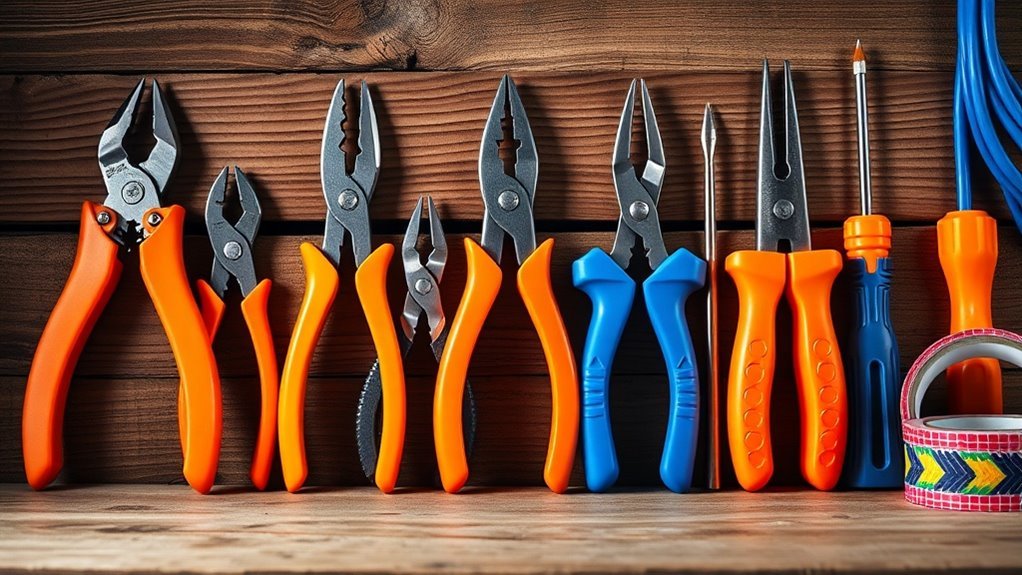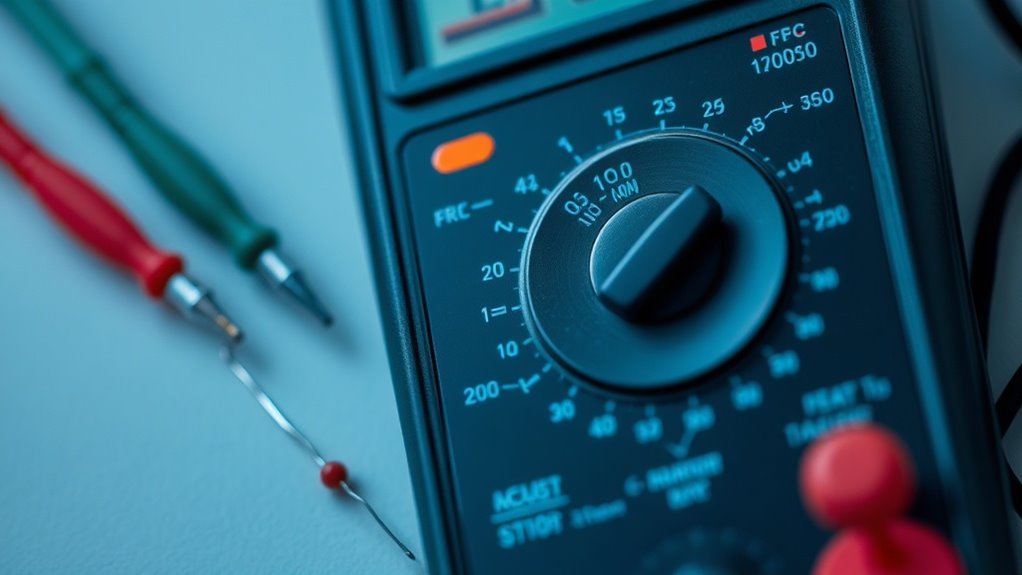Safe Handling of High-Voltage Tools

To safely handle high-voltage tools, you need to understand the risks like electric shock and burns. Always wear the right personal protective equipment (PPE), such as insulated gloves and dielectric boots. Regularly inspect your tools for damage and make certain they’re properly maintained. Work in a clutter-free, well-lit area to avoid accidents, and know your emergency response procedures. Staying informed about safety standards is essential. There’s more to learn about enhancing your safety protocols.
Key Takeaways
- Always wear appropriate personal protective equipment (PPE) like insulated gloves and dielectric boots when handling high-voltage tools.
- Regularly inspect and maintain tools to ensure they are functioning safely and free from damage.
- Work in a dry environment to reduce the risk of electrical conductivity and potential shock hazards.
- Keep your work area organized and well-lit to minimize hazards and improve safety while using high-voltage tools.
- Follow established emergency response procedures and maintain communication with emergency services for quick assistance in case of an incident.
Understanding High-Voltage Risks
How well do you understand the risks associated with high-voltage tools? Working with these tools can pose serious hazards, including electric shock, burns, and even death if you’re not careful.
The voltage across these devices can easily exceed 600 volts, making every task potentially dangerous. You need to be aware of the surroundings, ensuring no moisture or conductive materials are nearby.
People often underestimate the effects of arc flash, which can cause severe injury even from a distance; don’t let complacency set in. It’s essential to recognize that an accident can happen in a split second.
Always maintain a healthy respect for electricity and its potential consequences. Understanding these risks enables you to handle high-voltage tools safely and responsibly. Additionally, using well-insulated tools is essential to enhance user safety and minimize the risk of electrical shock.
Personal Protective Equipment (PPE)

When working with high-voltage tools, wearing the right personal protective equipment (PPE) is vital. You’ll need essential safety gear, such as insulated gloves and dielectric boots, to protect yourself from electrical hazards. Additionally, just like in DIY projects, using proper respiratory protection can help minimize exposure to harmful fumes and dust generated by high-voltage tools.
Essential Safety Gear
While working with high-voltage tools, wearing the right personal protective equipment (PPE) is essential to ensuring your safety.
Start with insulating gloves to protect your hands from electrical shock. High-voltage rubber boots are significant too; they keep you grounded and safe from accidental contact.
Don’t forget safety goggles to shield your eyes from sparks and debris. A hard hat can be critical if there’s a chance of falling objects or if you’re working in tight spaces.
Consider wearing hearing protection if you’re in a noisy environment. Finally, a flame-resistant jacket adds an extra layer of protection.
Prioritizing these PPE items will help keep you safe while you work on high-voltage tools. Always check your gear before starting any task!
Proper Equipment Usage
Once you’ve equipped yourself with the right personal protective equipment (PPE), understanding how to use it correctly is equally important.
Start by ensuring your gear fits well; loose clothing can snag or expose skin. Always wear safety gloves designed for electrical work, as they provide necessary insulation. Make sure your safety goggles are scratch-resistant and fit securely to protect your eyes from debris and sparks.
When handling high-voltage tools, check your PPE before each use for any damage or wear.
Maintain a clean workspace to minimize hazards, and never remove your protective gear until the job’s complete.
Finally, stay mindful of your surroundings and how your equipment interacts with high-voltage systems. This proactive approach can greatly reduce your risk of injury.
Proper Tool Inspection and Maintenance
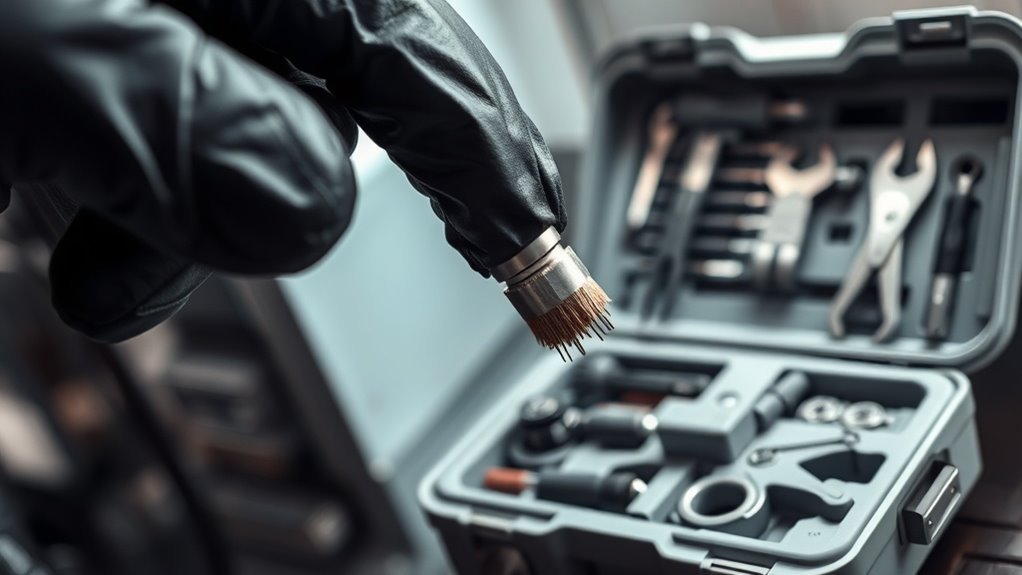
When it comes to high-voltage tools, proper inspection and maintenance are essential for your safety.
You should regularly perform visual checks and stick to a maintenance schedule to catch any issues early.
If you spot any signs of wear or damage, it’s important to know when to repair or replace your tools to keep yourself safe on the job. Additionally, incorporating fuse testers into your routine can help identify faulty tools and enhance overall electrical safety.
Visual Inspection Techniques
Visual inspection is a crucial part of maintaining high-voltage tools. Before using any tool, take a moment to inspect it visually. Look for signs of wear or damage, such as frayed cables, cracks in insulation, or loose connections.
Verify that all safety features are intact and functioning. Check for discoloration or burn marks which might indicate overheating. Also, examine the tool’s housing for any breaks or deformities.
Don’t forget to inspect the power source and make sure all plugs and sockets are free from debris. Taking the time to conduct these checks can prevent accidents and guarantee your tools operate efficiently.
If you spot any issues, it’s best to address them before use. Safety should always come first!
Regular Maintenance Schedule
Conducting regular inspections is just one part of maintaining high-voltage tools; establishing a maintenance schedule is equally important.
This schedule guarantees that your tools remain safe and functional, protecting you from unexpected hazards. When you dedicate time for maintenance, you foster a safer work environment.
Here are four key aspects to reflect on in your schedule:
- Daily Checks: Inspect cords, connectors, and casings for damage.
- Weekly Testing: Verify safety features, like circuit breakers, are operational.
- Monthly Cleaning: Remove dust and debris that can interfere with performance.
- Yearly Overhaul: Schedule a professional inspection to catch potential issues early.
Repair or Replace Guidelines
While maintaining high-voltage tools, knowing whether to repair or replace them often hinges on thorough inspection and assessment.
Start by examining the tool’s functionality; if it operates inconsistently or not at all, it may need repairs. Check for visible wear, such as frayed cords or damaged casings, which could compromise safety.
If repairs are minor and cost-effective, it’s usually worth fixing. However, for significant damage or if repair costs exceed half the tool’s value, replacement often makes more sense.
Regularly consult the manufacturer’s guidelines for recommended maintenance practices. Remember, investing in reliable tools guarantees your safety and efficiency.
Always prioritize high-quality replacements if you decide to upgrade; they’ll serve you better in the long run.
Safe Work Practices
To guarantee your safety when using high-voltage tools, it’s crucial to adopt consistent work practices.
These habits not only protect you but also instill confidence in your ability to handle electrical tasks.
Here are four key practices to keep in mind:
- Inspect Tools Regularly: Check for wear or damage before use; a small flaw can lead to serious accidents.
- Work in a Dry Environment: Moisture increases electrical conductivity, heightening risks of shock and injury.
- Use Personal Protective Equipment (PPE): Wear rubber gloves and insulated footwear to shield yourself from potential electrical hazards.
- Stay Focused and Avoid Distractions: Concentration is critical; distractions can lead to mistakes with dangerous consequences. Additionally, ensure that your tools are properly calibrated to maintain operational efficiency, which is essential for accurate readings and safety.
Electrical Safety Standards and Regulations
When it comes to electrical work, adhering to safety standards and regulations is non-negotiable. These guidelines are designed to protect you and those around you from potential hazards. Familiarize yourself with regulations set by organizations like OSHA and the National Electrical Code (NEC). They provide essential information on safe installation practices, equipment use, and maintenance procedures. Always verify your tools comply with these standards and carry appropriate certifications. It’s your responsibility to stay updated on any changes to these regulations, as neglecting them can lead to serious accidents or costly fines. Understanding safety gear standards is crucial for ensuring reliable protection while working with high-voltage tools.
Emergency Response Procedures
In emergency situations, it’s crucial to have a clear plan in place so you can respond quickly and effectively.
When it comes to high-voltage tools, your immediate actions can save lives and prevent further injury. Here’s what you should do:
- Shut off the power: Locate the main switch and cut the electricity to prevent additional hazards.
- Call for help: Don’t hesitate—notify emergency services right away for professional assistance.
- Administer first aid: If it’s safe, check on anyone injured and apply basic first aid until help arrives.
- Stay calm: Your composure can help others remain focused and reduce panic during a crisis.
Following these steps can make all the difference when seconds count. It’s important to remember that insulation materials play a crucial role in preventing electrical hazards, so ensure your safety gear is up to industry standards.
Training and Certification Requirements
Understanding emergency response procedures is just the first step in guaranteeing safety around high-voltage tools. You’ll need proper training and certification to manage risks effectively. Organizations often require specific programs to keep you informed about safety protocols and equipment handling. This knowledge isn’t just about compliance; it’s about protecting yourself and your coworkers.
| Training Type | Certification Issued | Importance |
|---|---|---|
| High-Voltage Safety | HV Technician | Essential for safety |
| Electrical Basics | Electrical Worker | Foundation for skills |
| First Aid Training | First Aid Responder | Critical life-saving |
| Tool-Specific Course | Tool Specialist | Specialized knowledge |
Investing time in training guarantees you’re equipped to handle high-voltage tools with confidence and integrity.
Keeping Your Work Area Safe
A safe work area is crucial for anyone handling high-voltage tools. When you’re working with such equipment, your surroundings play a critical role in your safety.
Here are four key steps to guarantee your workspace is secure:
- Remove clutter: A clean area helps you focus and minimizes the risk of accidents.
- Inspect tools regularly: Check for damage or wear that could potentially lead to shock or injury.
- Use proper lighting: Bright, appropriate lighting allows you to see clearly, reducing mistakes.
- Maintain proper ventilation: Good airflow prevents overheating and reduces any fumes or odors that can be harmful.
Questions
What Are the Most Common High-Voltage Tools Used in the Industry?
In the industry, you’ll commonly encounter tools like insulated voltage testers, high-voltage circuit breakers, power transformers, and cable cutters. Each serves a unique purpose, ensuring efficient operation and maintenance of electrical systems in various applications.
How Can I Identify Signs of Tool Wear or Damage?
You can identify signs of tool wear or damage by inspecting for frayed cords, cracks in the casing, rust, or unusual noises during operation. Regular checks help guarantee your tools remain safe and effective for use.
What Are the Consequences of Neglecting High-Voltage Safety?
Neglecting high-voltage safety can lead to severe injuries, electric shocks, or even fatalities. You could also face legal repercussions, equipment damage, and increased costs. It’s vital to prioritize safety to prevent these serious consequences.
Are There Specific First Aid Measures for Electrical Shocks?
If someone experiences an electrical shock, you should first call for emergency help, then check their breathing and pulse. If needed, perform CPR and use an AED if available until professional assistance arrives.
Can I Use Household Tools for High-Voltage Applications?
You wouldn’t try to swim with a cement block, right? Similarly, using household tools for high-voltage applications isn’t safe. They’re not designed for the task, risking injury or damage. Always choose the right tools.
Conclusion
To summarize, staying safe while handling high-voltage tools isn’t just a precaution—it’s your lifeline. By understanding risks, using the right PPE, and practicing safe work habits, you can protect yourself from the unseen dangers that lurk behind every tool. Remember, knowledge is your shield, and preparation is your sword. So, gear up, stay vigilant, and make safety your top priority, because when it comes to high voltage, it’s always better to be safe than sorry.


